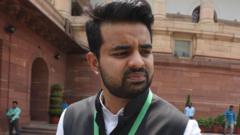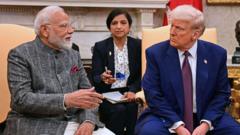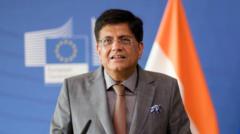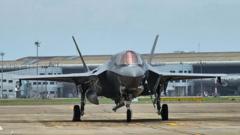As millions gather for the Maha Kumbh Mela in Prayagraj, the event serves as a stage for Prime Minister Modi's political narrative. However, safety issues have emerged, culminating in a tragic stampede that has drawn scrutiny and criticism of governmental response regarding public safety.
Tragedy at the Maha Kumbh Mela: A Political Showcase Amidst Pilgrimage

Tragedy at the Maha Kumbh Mela: A Political Showcase Amidst Pilgrimage
The Maha Kumbh Mela, a significant Hindu pilgrimage, attracts millions but also raises concerns after a stampede left dozens dead, highlighting political undertones in India's largest gathering.
The Maha Kumbh Mela, an event drawing Hindu pilgrims from across the globe, is taking place this year in Prayagraj, India, where the sacred rivers Ganges and Yamuna converge. In this gathering, the aura of spirituality intertwines with political narratives as Prime Minister Narendra Modi and Uttar Pradesh Chief Minister Yogi Adityanath dominate the promotional landscape, their images displayed prominently across the event. Pilgrims flock to the waters in the belief that immersion brings purification and spiritual liberation.
The scale of the festival is staggering, resembling a city with its infrastructure designed to facilitate the millions attending. This year, amidst the diverse congregants—ranging from ascetic monks to international tourists—the festival has become a monumental platform for political showcase. Modi's administration seeks to project India as a showcase of cultural and spiritual unity, leveraging this vast demographic for political capital and public support.
However, the festivity took a somber turn when a tragic stampede resulted in the loss of approximately 30 lives, with many others injured. The incident raised serious concerns regarding the safety measures in place, especially given the enormity of the crowd. Criticism emerged as Chief Minister Adityanath's delayed acknowledgment of the incident sparked accusations of negligence towards public safety.
As the tragedy unfolded, it served as a stark reminder that beneath the vibrant festival atmosphere lies the pressing need for attention to human welfare, pointing to the complexities of managing such a monumental gathering. In the wake of this calamity, questions linger about the balance between showcasing political successes and ensuring the safety of all participants at one of the world's largest gatherings.
The scale of the festival is staggering, resembling a city with its infrastructure designed to facilitate the millions attending. This year, amidst the diverse congregants—ranging from ascetic monks to international tourists—the festival has become a monumental platform for political showcase. Modi's administration seeks to project India as a showcase of cultural and spiritual unity, leveraging this vast demographic for political capital and public support.
However, the festivity took a somber turn when a tragic stampede resulted in the loss of approximately 30 lives, with many others injured. The incident raised serious concerns regarding the safety measures in place, especially given the enormity of the crowd. Criticism emerged as Chief Minister Adityanath's delayed acknowledgment of the incident sparked accusations of negligence towards public safety.
As the tragedy unfolded, it served as a stark reminder that beneath the vibrant festival atmosphere lies the pressing need for attention to human welfare, pointing to the complexities of managing such a monumental gathering. In the wake of this calamity, questions linger about the balance between showcasing political successes and ensuring the safety of all participants at one of the world's largest gatherings.



















